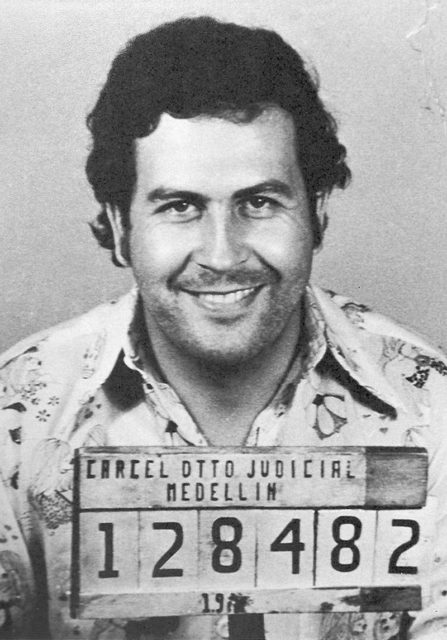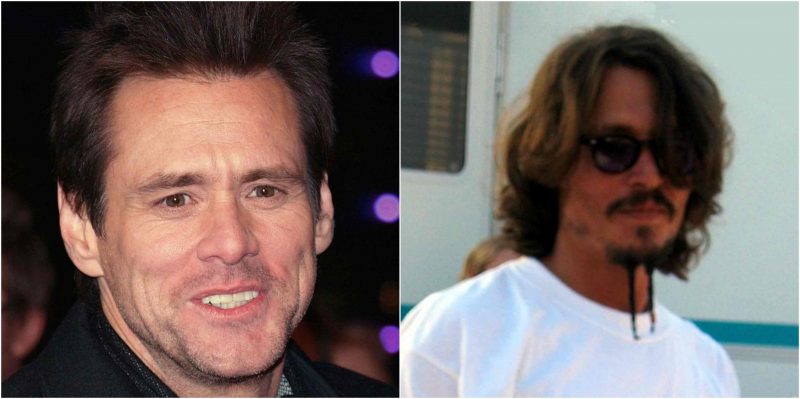Pablo Escobar was born in Antioquia, Colombia, in December 1949, to a school teacher and a farmer. Rather than using patience and hard work to get above his station in life, Escobar turned to crime. He began with petty theft and stealing cars, and eventually moved up to smuggling cigarettes.
By the early 1970s, Colombia had become heavily involved in the cocaine business. Its proximity to the coca cultivation in Peru and Bolivia allowed Colombia to seize the market for cocaine. Escobar joined with other drug smugglers to form the Medellín Cartel, which ended up controlling over 80% of the cocaine shipped to the United States. In the mid-1980s, as much as fifteen tons were being smuggled into America on a daily basis, bringing the cartel nearly four hundred and twenty million dollars a week. By the age of twenty-six, Escobar was depositing sums of over three million US dollars into his bank and owned a smuggling fleet of over fifteen airplanes, six helicopters, and a personal Lear jet. According to his brother, Roberto, he also had two small submarines in his smuggling fleet.

At first, Escobar was a popular figure among Colombians as a champion of the poor and elderly. He also contributed to the country’s hugely popular football programs. Escobar was even elected as an alternate member of the Chamber of Representatives of Colombia.
However, the drug kingpin soon became one of the most feared and powerful men in the world. He ordered assassinations, sponsored terrorist attacks, had high-ranking officials intimidated and bribed, orchestrated coups, and was able to get the extradition laws between Colombia and the United States changed for his own benefit. He paid townspeople to act as lookouts and gave handsome bonuses for killing police officers. In 1992, over 600 of the 20,000 violent deaths that occurred in Colombia were those of police officers.
The government went after Escobar and the other drug cartels after the assassination of Luis Carlos Galán, a candidate for President in 1982 and 1987 who was a self-proclaimed enemy of the drug cartels. A treaty between the U.S. and Colombia allowed the extradition of any Colombian suspected of drug trafficking into the United States, where they could be put on trial in US courts. It became clear that Pablo Escobar would have to surrender to the authorities, but he refused to do so. He went so far as to instigate a war against the Colombian government to stop the extradition treaty.
La Catedral: The Luxury Prison Pablo Escobar built HIMSELF overlooking Medellin pic.twitter.com/vXUqDWkvBa
— Senzokuhle Sithebe (@SkinnySenz_77) October 7, 2016
Escobar began negotiations with the President, asking that the government abolish the extradition rule; he wanted to build his own prison and use his own guards, with no police involvement. Escobar was at war with Los Pepes (People Persecuted by Pablo Escobar) and the rival Cali Cartel. He was being pursued by Los Pepes, who would ultimately murder over 300 of his associates and family members. The police had already killed Gustavo Gaviria, Escobar’s cousin and the financial head of the Medellín cartel. After six months of secret talks, to get the situation out of the public eye, the Colombian government gave in to Escobar’s demands.
I took a hike up to Escobar’s famous La Catedral prison. Good #research and the view was fantastic! #narcos #lacatedral #medellin pic.twitter.com/z8ZtQhxUhm
— Jay Tinsiano (@jaytinsiano) February 20, 2017
Escobar built his own prison, naming it La Catedral, but unofficially it was called “Club Medellin” or “Hotel Escobar”. The compound sat on almost seven acres of land in the hills where Escobar had played as a child. He chose a location that allowed a direct line of sight to the home of his family, and he supposedly mounted a telescope so that he was able to see them.
The compound featured a circular, rotating bed and a Jacuzzi tub. The “prison” also included a disco, a soccer field, a pool hall including game tables for Backgammon, numerous bedrooms with king size beds, the latest electronic equipment of the time, and several kitchens, including one with stainless steel, restaurant-size appliances. In one of the kitchens, his own framed WANTED poster adorned the wall. There were several parlors, a weight room, offices, and a sophisticated alarm system. A YouTube video entitled Carcel donde estuvo Pablo Escobar shows the prison immediately after Escobar’s escape.
A truck would come to the complex weekly to bring “necessities” for Escobar and the guards; female guests for Escobar’s men were often included among the “necessities”. His family, friends, partners, and various professional football players visited him several times a week. He hosted parties and continued to traffic cocaine into the United States. The Colombian authorities ignored all of this activity to avoid national humiliation and to keep the status quo.
When Escobar brought four of his lieutenants to La Catedral to be tortured and murdered over a financial dispute, the Colombian government looked the other way but proposed to move Escobar to a standard prison. He refused to comply, and in July of 1992, after serving thirteen months of a five-year sentence, Escobar slipped through the Colombian National Army surrounding his compound and escaped. The subsequent manhunt engaged Search Bloc, a 600-man unit trained by the United States Delta Force and led by Colonel Hugo Martínez. A bounty of six million dollars was put on Escobar’s head.
The view from La Catedral the prison Pablo Escobar built for himself. #pabloescobar #thelifeofpablo #medellin #colombia pic.twitter.com/9gdRI7BS4h
— World Wide Nate (@WorldWideNate) October 21, 2016
A year and a half after his escape, after having moved from one safe house to another, the Search Bloc caught up with Escobar and killed him in a shootout on December 12, 1993. After his death, La Catedral and many of Escobar’s other properties were abandoned, except for occasional visits from treasure hunters, police, and journalists.
La Catedral was later acquired by the city of Envigado. In 2007, Benedictine monks from Benedictine Fraterdina Monastica Santa Gertrudis moved into the compound and built a chapel, cafeteria, library, and living quarters. The city gave the land to the monastery to enable them to build a shelter for the poor and elderly, which is currently under construction.
